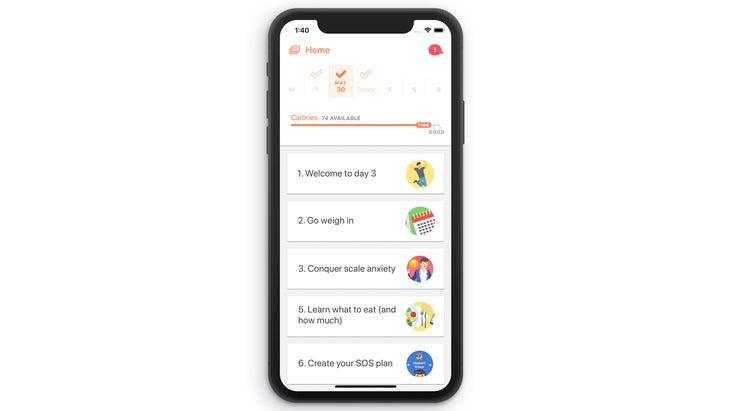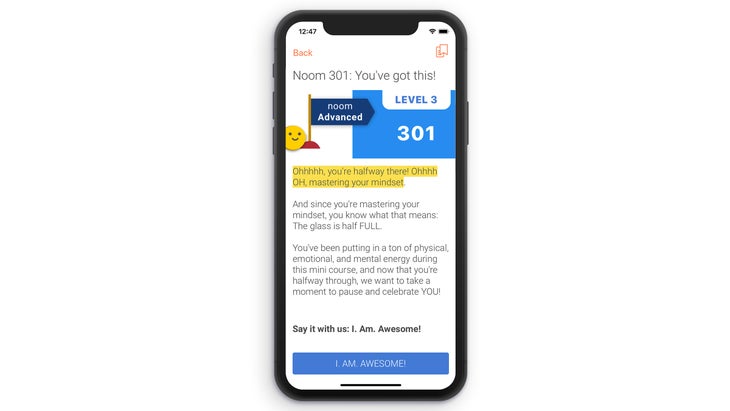Don’t Be Fooled, Noom Is Just Another Diet
8 min read“],”renderIntial”:accurate,”wordCount”:350″>
Noom isn’t supposed to be a diet regime. The app is a bodyweight-loss program, of course, but it is unique: “designed by psychologists & scientifically verified to build authentic, sustainable results,” its advertising duplicate reads. If you are ill of dieting, the adverts say, Noom is for you. The personalized health and fitness-coaching firm was launched in 2008 by two engineers, Saeju Jeong and Artem Petakov, and it took off when they released an app in 2016. It claims to train sustainable health and fitness behaviors and mindful consuming, and to increase your romance with meals and your overall body by means of an individualized program. For most end users, the target is bodyweight loss.
Plainly, the concept is resonating with folks. In accordance to Forbes, Noom has been downloaded a lot more than fifty million occasions due to the fact its launch five many years in the past. In May well 2021, TechCrunch documented that the firm lifted an astounding $540 million in Sequence F funding. (For reference, Peloton lifted $550 million in the similar funding stage in 2018.) It is secure to say, Noom is substantial and it is going to continue to keep developing.
But guiding Noom’s acceptance and slick “no dieting needed” advertising, it is seriously just a different diet regime. The app is in essence a calorie tracker supplemented by lessons on actions modify and a own coach who messages you. Several diet and mental health and fitness specialists have warned that the way Noom presents itself is deceptive.

Earlier this summer, I signed up for the two-week absolutely free trial model of Noom (which then goes on to charge $59 for every month or $199 for every calendar year). Immediately after downloading the app, I filled out an original survey that questioned for basic info like my gender, bodyweight, way of living, aims, and meals preferences. I enter a bodyweight-loss target of twelve lbs ., and it gave me a timeline suggesting when I could realistically meet that goal—about 7 weeks. Technically, which is in line with the 1 to two lbs . for every week that the Facilities for Illness Command and Prevention (CDC) considers healthful.
I swiped my way by a welcome that provided a handful of many-choice thoughts, together with 1 that read, “What’s the best way to arrive at your bodyweight loss aims with Noom?” The accurate response was “Simply feel.” I was also assigned a Noom coach, a female named Laura, who despatched me a concept by the app’s chat attribute, expressing that she was there to supply assistance and response thoughts. Then there ended up a handful of swipe-by lessons about Noom’s technique, which is intended to be flexible, intuitive, and motivating.
On working day two, I opened the app and observed, at the major of the screen, a calorie target for the working day: 1,200. Presented all of Noom’s communicate of psychology, actions modify, and not staying a diet regime, I was astonished that it anticipated me to track my energy at all. But I was a lot more stunned by the significantly minimal suggestion.
“Our bodies want a bare-least amount of energy to continue to keep us alive and continue to keep our coronary heart pumping,” claims Danielle Bublitz, an anti-diet regime dietitian centered in the Los Angeles area. That least range differs, but the Academy of Nutrition and Dietetics claims that most females want concerning 1,600 and two,200 energy for every working day, and most men want concerning two,000 and 3,200.
I arrived at out to Noom as a reporter, asking for clarification on how it calculated my (particularly minimal) caloric allotment, and a representative advised me that Noom bases the suggestion on user info, wished-for velocity of bodyweight loss, and rules from the Harris-Benedict Equation, a formulation grounded in legit science and usually made use of by health and fitness treatment industry experts to estimate someone’s basal metabolic level (BMR) and complete strength expenditure.
For comparison, I plugged my peak, bodyweight, age, and gender into the Harris-Benedict Equation (commonly accessible online) and acquired a BMR—the least range of energy necessary just to function—of 1,486 energy for every day—286 a lot more than Noom’s suggestion. Factoring in my action degree, the online calculator extra an supplemental 1,000 energy to my complete strength expenditure, the approximated range of energy burned day-to-day when action is taken into account. For the reason that my overall body mass index falls in the usual bodyweight group, the CDC endorses no a lot more than a 500-calorie deficit for bodyweight loss—which intended I need to be consuming about two,000 energy for every working day. Which is 800 energy greater than Noom’s suggestion. (The CDC also details out that even “healthy” bodyweight loss normally plateaus soon after 6 months, and most folks conclusion up regaining any bodyweight dropped.)
I questioned irrespective of whether Noom’s caloric suggestion was a lot more precise for many others, so I posted about it on social media. Various dozen females messaged me expressing that Noom experienced recommended them the specific-similar caloric target. Several of them also shared their peak, bodyweight, and age—our weights ranged a lot more than 100 lbs ., and our ages spanned a few decades. It is tricky to fathom how all of us could have legitimately finished up with the similar suggestion.
I questioned Noom about this, and a representative advised me above e-mail that 1,200 is the least amount assigned to females. “Many Noom end users pick the fastest velocity of bodyweight loss, which equates to getting rid of close to two lbs . for every week,” they reported. But you never explicitly pick out your level of bodyweight loss up front—the survey will take you by a series of thoughts and visually shortens your bodyweight loss timeline centered on your solutions. You can change your bodyweight loss velocity in settings, but it is not intuitive, nor is the choice foregrounded in the user expertise.
“Noom’s calorie price range is not a rigid suggestion but a setting up position,” the representative advised me. “We’ve been doing work on the best way to visually characterize this philosophy inside of the platform.”

Noom nutritional supplements its calorie monitoring with a stoplight-motivated meals-categorization program centered on caloric density. Calorically dense foods like olive oil, dried fruit, and French fries are crimson, somewhat lighter possibilities like whole-grain bread and grilled hen breast are yellow, and points like berries, egg whites, and nonfat dairy are eco-friendly. The app endorses escalating the amount of eco-friendly foods you eat and limiting crimson types. Although it tries to clarify that crimson foods are not inherently lousy, and acknowledges that a healthful diet regime features all a few types, the colors are obviously affiliated with authorization and a lack thereof from there it isn’t tricky to make a leap to thinking of selected foods as good and many others as the reverse. Amy Porto, a dietitian and diet professor at Messiah University in Pennsylvania, claims that thinking about meals in this sort of a binary way can be harmful, simply because it qualified prospects to inner thoughts of guilt and disgrace when an individual eats a “bad” meals.
Also relating to is Noom’s lack of consuming-disorder screening. Though a Noom representative advised me by means of e-mail that coaches are qualified to be “hypervigilant” and enjoy for symptoms that a user is battling, its original survey does not check with about consuming-disorder background or romance with meals. Alexis Conason, a New York–based psychologist, consuming-disorder expert, and writer of The Diet regime-Free of charge Revolution, has authentic concerns about this. Several of her consuming-disorder customers have attempted Noom, thinking it would enable their restoration and not acknowledging that it was in point a calorie tracker.
“People commence the program and discover that it is incredibly triggering,” Conason claims. “It goes towards every little thing that the anti-diet regime movement is about.”
Noom regularly details out that it incorporates psychological exploration to enable end users get rid of bodyweight securely and sustainably. The premise of this psychology-centered technique is cognitive behavioral therapy, a form of treatment method concentrated on altering people’s feelings and inner thoughts as a way to modify their behaviors. But even though CBT is legit, Noom’s application of it appears to be a great deal unique than it would in a medical placing, in which a licensed therapist would administer it in ongoing, 1-on-1 counseling sessions. On Noom, end users read brief lessons about actions modify and could get weekly messages of encouragement from their coach.
Even a psychologist very likely wouldn’t be able to effectively administer CBT by messages in an app, Conason claims. And Noom’s coaches are not licensed therapists—instead, they enroll in Noomiversity, a seventy five-hour “health and wellness coach coaching program,” soon after which they clock 200 several hours of coaching expertise, a Noom representative advised me by means of e-mail. These coaches sign nondisclosure agreements and as a result could not communicate to me on the file, but several Glassdoor reviews say that every single coach is assigned to upward of 350 energetic Noom end users at a time. In comparison, a comprehensive caseload for a licensed therapist is normally somewhere concerning 15 and thirty customers for every week.
Like other eating plans out there, Noom does not guide to extensive-term bodyweight loss for most folks who download the app. In a “learn more” page on the app, Noom cites a statistic that seventy eight percent of its end users get rid of bodyweight. But that range, which will come from a review of its methodology posted in Character in 2016, is a little deceptive, clarifies Conason. When the authors gathered the information, ten million folks experienced downloaded Noom, but the firm only pulled information from 36,000 folks, simply because the other 99.6 percent of end users quit the app just before 6 months.
There’s not a great deal information to back again up extensive-term bodyweight loss of Noom end users, possibly. Of all those 36,000 folks, 15,000 ended up provided in a 1-calendar year observe-up, significantly less than .5 percent of the first sample measurement, and the information about their encounters is opaque: 38 percent of that tiny team is lacking from the information table, and just 24 percent taken care of bodyweight loss for a calendar year.
Despite its acceptance and intelligent advertising, Noom is basically a calorie-counting app with a chat attribute and chunk-measurement lessons on consuming and bodyweight loss. If you are established on trying to get rid of weight—although I’d encourage you to rethink this, as most eating plans fail and bodyweight loss isn’t vital for improved health—there are a lot more sustainable paths out there. Consult with a registered dietitian and maybe a licensed therapist, and come up with a approach that is truly individualized to your overall body, your background, and your aims.






